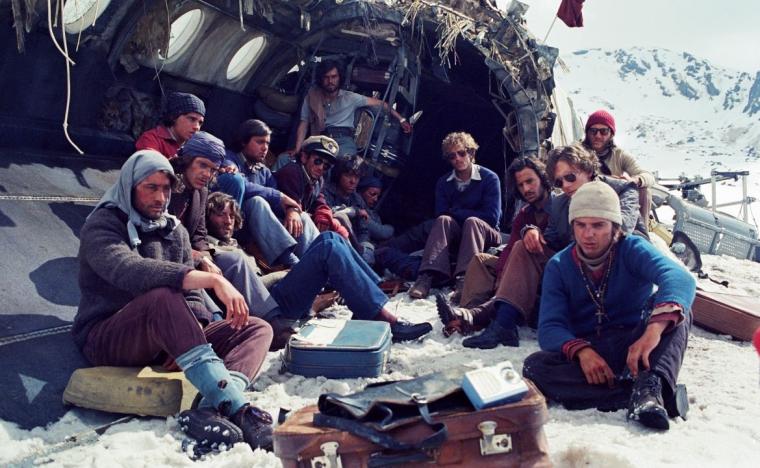
Society of the Snow
I intended to cover our area's one new theatrical release – the Blumhouse chiller Night Swim – in this article, but an automotive emergency forced me to turn around en route to the Davenport cineplex, and my engine promptly died upon returning home to Rock Island. I will be initiating a GoFundMe campaign for its repair. (Kidding. Unless any of you are interested in contributing … ?) In the meantime, you get my thoughts on four streaming titles – three of them new, one far-less so. You know, back in the old days, car trauma might've gotten me out of a weekly reviewing obligation. Damn you, streaming!
SOCIETY OF THE SNOW
It arrived a few days late, but the undisputed movie tearjerker of 2023 finally landed in '24 with Thursday's Netflix debut of Society of the Snow, writer/director J.A. Bayona's foreign-language survival thriller about the 1972 Uruguayan Air Force Flight 571 disaster. For those old enough to remember news of the event, this was the plane crash that found 16 surviving passengers spending 10 weeks in the snow-covered Andes before their rescue with no heat and no obvious access to food. Those under 40 might instead recall it as the inspiration for Frank Marshall's Alive, the 1993 drama in which Ethan Hawke and company were forced to resort to cannibalism. While hardly great, Marshall's film at least presented its tragedy and subsequent triumph with dignity. It didn't, however, dive into its subject with the visceral force and aching emotionalism of Bayona's, a work that might make you instantly regret your nervous giggles during the flashbacks in Showtime's Yellowjackets, or your howls at Rick & Morty's Emmy-winning “The Vat of Acid Episode.”
With his movie based on Pablo Vierci's group testimony La socieded de la nieve, which includes accounts of the experience from all 16 survivors, Bayona and co-screenwriters Bernat Vilaplana, Jaime Marques, and Nicolás Casariego don't spent an awful lot of time with the flight's manifest before sending them to their fates. For the most part, they're gregarious, fun-loving athletes in their 20s – 19 of the passengers were members of Uruguay's Old Christians Club rugby team; most of the rest their friends, family, and fans – whose incessant cheer and optimism would have you expecting the worst even if you didn't know where this tale was leading. Chief among them, for narrative purposes, is Numa Turcatti (Enzo Vogrinic Roldán), whose best friend Pancho (Valentino Alonso) all but strong-arms him into taking the flight with the (subtitled) words, “This could be our last trip together!” That's a warning-bell line if ever I've heard one, and you can sense exposition being overtly laid out when teammates begin discussing the hazards of traveling through the Andes via aircraft, Bayona and his co-scribes essentially detailing what transpires with the plane before the disaster occurs. None of this is necessarily lazy or ineffective. Yet you might still find yourself unreasonably antsy for the plane crash. Then it happens, and you wish it never did.
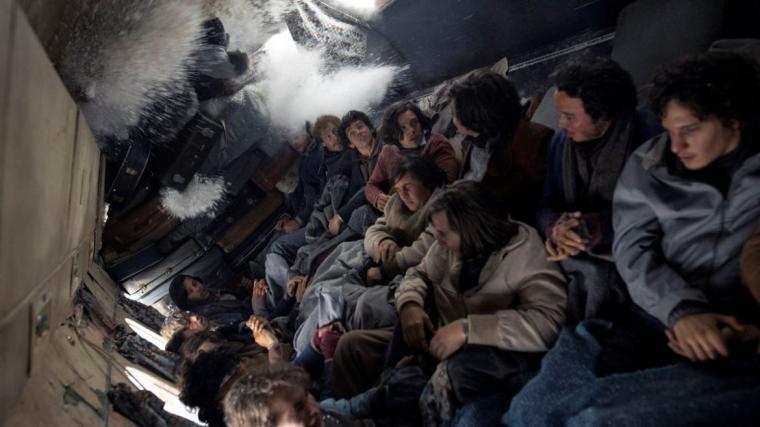
There are plenty of movies that will never, in any multiverse, serve as in-flight-entertainment options: Fearless; Cast Away; United 93. Society of the Snow may very well shoot to the top of the list. Bayona initially made his name with the scrappy Spanish Gothic The Orphanage before his budgets increased with The Impossible (another survival drama), A Monster Calls, and Jurassic World: Fallen Kingdom (yet another survival drama … I suppose ...). In terms of scale, the visual effects in his latest are most suggestive of that latter title, except their employment is no fun at all. Flight 571's demolition after colliding with a mountain is horrifying. The vessel is torn to shreds, passengers are blown out of the plane's newly exposed rear, the seats collapse like a pushed accordion, travelers are impaled or have their limbs snapped into unnatural positions … . You're grateful for the silence and darkness that follow Bayona's visual and aural assault. That, however, comes with its own terror, because for two thoroughly gripping yet largely grueling hours afterward, our survivors' object is merely staying alive.
Thankfully, it's intensely clear from the start – or at least, from after the crash – that Bayona won't be indulging in any untoward sensationalism. As the deceased are counted, Society of the Snow's director lists their names and ages on-screen one by one, allowing us to reflect on their passing at the same time their fellow passengers do. (This practice continues whenever any of the initial survivors succumb to hunger or their injuries.) Although characters occasionally argue over potential courses of action, there's so movie-style showboating; no scene in which two hotheads lay into each other before the flight's figure of righteousness advises them to calm down or they'll never get anywhere.
Perhaps most gratifying is the film's approach to the inevitable cannibalism – though I recently larned that the term “anthropophagy” is more appropriate, as it doesn't imply murder or any kind of want. Rather than delaying the practice for dramatic effect, the writing team introduces the subject before the film's 144 minutes are half over, and most of the living agree it's their only possible means of survival. The conflict comes from these devout Catholics (recall their rugby-team name) feeling it immoral to consume their fellow travelers' flesh because they weren't given consent – that the act wouldn't be heinous so much as unholy. Needless to say, no one is given any choice but to eventually acquiesce, which leads to maybe the most moving recurring motif: living passengers stating plainly, firmly, that in the case of their deaths, they give their permission to be used as a source of food.
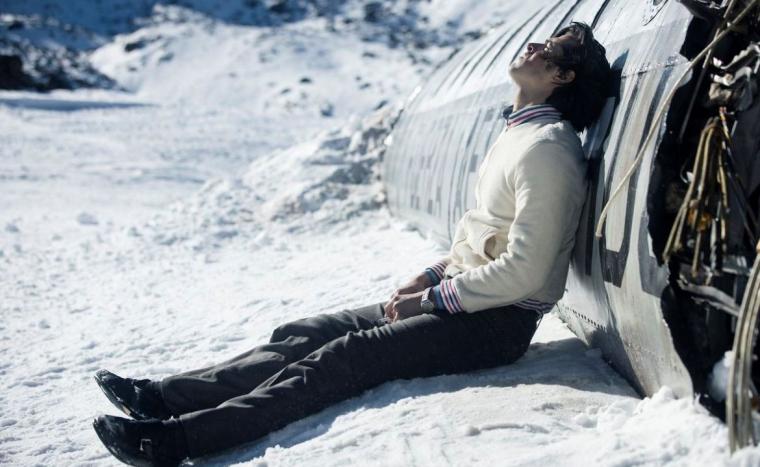
For what it's worth, the subsequent dismembering and digestion is handled with the utmost tact. That doesn't mean Society of the Snow lets you off the hook anywhere else. From the sight of a survivor pissing black urine to the routinely hideous examples of frostbitten faces, fingers, and feet, Bayona's movie almost physically hurts. So, too, does the sequence in which our heroes finally get the crashed plane's radio to function, only to learn that the Uruguayan government has called off all rescue attempts until the Andes weather becomes more hospitable. So much misery makes you almost pathetically grateful for rare moments of levity, as when the freezing teammates, huddling in what remains of the fuselage, challenge one another to a de facto poetry slam. It's a beautiful moment of brotherhood and tenderness ... and might have remained so had the men's enthusiastic clapping not set off an avalanche that buries what's left of the plane in snow.
In case I've been at all unclear, this is a tough sit. It's also a soul-cleansing, ultimately deeply inspiring one, because what makes Bayona's film a grade-A tearjerker isn't the suffering – it's the unshakable camaraderie of the survivors, and their problem-solving determination, and their seemingly bottomless reserves of faith and love. Without a bum performance in sight (and most of Bayona's cast is composed of novice actors), you feel the survivors' mutual affection as surely as you feel the unfathomable chill, and while I welled up during several scenes, I'll admit to being a blubbering mess for the movie's final 20 minutes, when the full meaning of the saga's “Miracle in the Andes” nickname comes into razor-sharp focus. Even the arguably manipulative narrative twist a half-hour before the climax felt, to me, absolutely earned. Society of the Snow is Spain's official contender for this year's Best International Feature Film Oscar (and was a Best Non-English-Language Film contender at last night's Golden Globes), and while I'm too unfamiliar with the competition to say that it deserves to be, I certainly don't think Bayona's marvelous achievement will be lost to the Netflix wilderness any time soon.
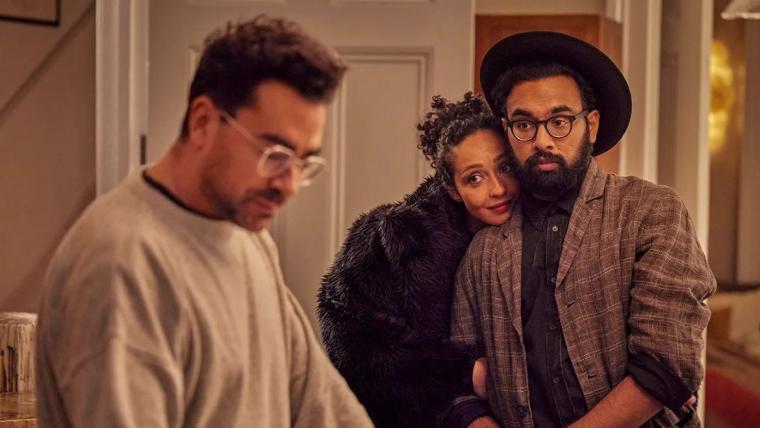
GOOD GRIEF
By contrast, writer/director/star Daniel Levy's Good Grief premiered on Netflix a day after Bayona's movie did, and it already feels like it's been years since I watched it. This isn't strictly a complaint. I'll always be game for whatever the Schitt's Creek veteran puts his imprint on, and his gentle tragicomedy is intermittently amusing and certainly easy to sit through. Yet it still feels like a Sundance-y relic from many moons ago – one in which our protagonist has one sardonic, gay male bestie and one kooky, straight female bestie, and no one's crises are necessarily life-altering because at least they have all this money to fall back on. Good Grief might almost be the prototypical Netflix Movie: a work designed to be consumed and enjoyed, and within minutes, easily forgotten.
The grief of the title is twofold, as it involves Levy's painter Marc (a) contending with the death of his beloved husband Oliver (Luke Evans) in a Christmas-Eve car accident, and a year later, (b) learning that Oliver intended to leave him and their London flat, and had procured a Parisian apartment that Marc knew nothing about. Most of this continental tale subsequently unfurls in the City of Lights, where Marc invites gay pal Thomas (Himesh Patel) and straight pal Sophie (Ruth Negga) on a getaway without informing them that the place they're staying in is actually Oliver's. Yeah, the whole of Good Grief runs on this sort of only-in-the-movies contrivance, which only gets more conveniently sticky when Marc has a Meet Cute with a dashing Frenchman (Arnaud Valois) and Oliver's formerly unknown boyfriend (Medhi Baki) pops by for a visit. Given that Oliver was a J.K. Rowling-level children's-book author, that Marc is able to quit working for a year with nothing in the way of monetary concerns, and that even Thomas and Sophie appear financially secure despite neither, to my recollection, having a job, a Frederick Wiseman documentary this obviously ain't. Still, it's innocuous and pleasant enough, and of particular note for the massive shakeup it gives to Ruth Negga's screen persona.
Levy doesn't extend an inch beyond his well-honed comfort zone here, which is perfectly acceptable, even welcome, and Patel is wonderfully ingratiating and emotionally honest; he may be physiologically incapable of a bad performance. It's Negga, though, who grabs the film by its lapels and shakes it, completely trashing the recognizable delicate-to-the-point-of-breaking fragility she previously demonstrated playing Americans in her Oscar-nominated turn in Loving and her haunting society gal in Passing. (Not for nothing did Vulture magazine label Negga “the gerund queen.”) Here, her flamboyantly accessorized booze-hound is boisterous, and funny, and adorable, and Irish as all get-out – what a treat to finally hear Negga speak in her natural dialect! And if the performer almost seems too much at times, even that proves fitting, because as Sophie herself admits, she's too much, too. Even as Good Grief vanishes from my consciousness, memories of Negga's energetic turn will likely persist. It's as if she had spent the past several years in a cinematic cocoon, and instead of a butterfly finally emerging, a Celtic Cyndi Lauper spilled out.
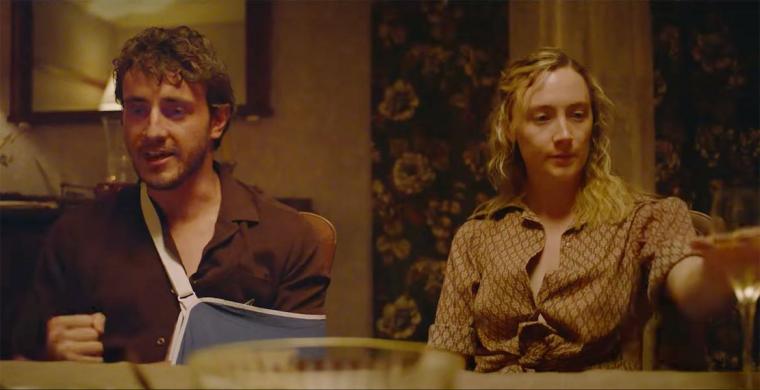
FOE
Speaking of the Irish, there are no circumstances under which I wouldn't want to watch the beautiful, fiercely talented equals Saoirse Ronan and Paul Mescal paired on-screen. Or rather, I thought there weren't, and then I watched writer/director Garth Davis' turgid science-fiction drag Foe, which recently started streaming on Prime Video. The 29-year-old, four-times-Oscar-nominated Ronan has appeared in nearly three-dozen movies since her 2007 debut, so a few losers have naturally come her way: The Lovely Bones; The Host; On Chesil Beach. By contrast, 27-year-old Normal People heartthrob Mescal – a Best Actor nominee for last year's Aftersun – only has seven film credits thus far including the soon-to-be-arriving All of Us Strangers, and was a complete newbie to the world of lousy projects. Well, he's got one now. It's not a good color on him.
This is especially disappointing because nothing about Foe, in advance, suggested a turkey slowly roasting in the oven. Davis is a Director's Guild of America Award recipient for 2016's Oscar-nominated Lion, and the script was co-written by Iain Reid, whose novel served as the film's inspiration and whose I'm Thinking of Ending Things turned into a surreal, appropriately COVID-y triumph for Charlie Kaufman in 2020. Plus, it had Ronan and Mescal, who can continually be counted on for maximum empathy and relatability … and who, not for nothing, are apparently on-board with the required nudity. (A normal state of affairs for Mescal; a relative shock for Ronan.)
But nothing about this obnoxiously redundant, slow-moving time-suck works. Not the premise that finds a stranger (Aaron Pierre) landing at the farmhouse of Ronan's Hen and Mescal's Junior with the promise of a life-altering space-station job for the latter in the climate-ruined U.S. of 2065; not the Black Mirror-esque setup – one eerily similar to “Be Right Back”'s – in which a humanoid replica of Junior is to be stationed in his place; not the emotional tug-of-war that such an offer presents. Not even that Hen and Junior are meant to be American, as the actors' knotty attempts at flat Midwestern accents sound remotely believable. Despite Ronan's and Mescal's performance gravitas, it's tough to even glean intent from their unconvincing readings. (Davis' film almost makes you look back fondly on that Netflix abomination Leave the World Behind, which at least had more than three talented actors on hand.) I'd continue on about Foe's failings if doing so didn't make me inordinately depressed. Please consider skipping it, and next time you're searching for streaming options involving either of its stars who will surely, quickly put this bummer behind them, check out Aftersun or Lady Bird instead. Even on a repeat viewing, either one is 100 minutes way-better spent.
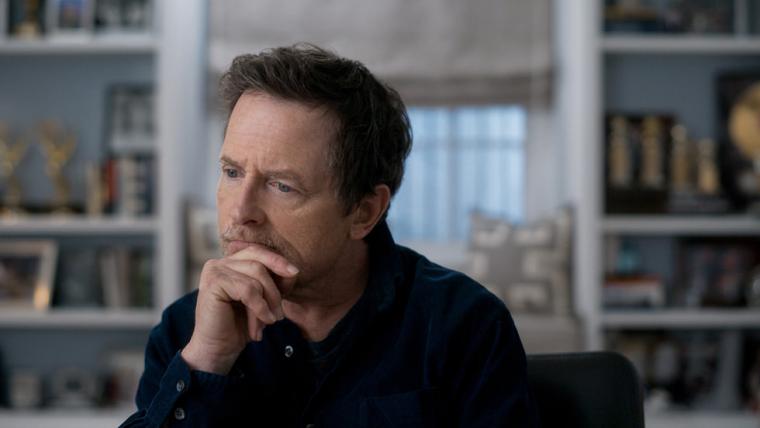
STILL: A MICHAEL J. FOX MOVIE
Last night, on the second evening of creative-arts trophy-distribution for the Primetime Emmy Awards, Still: A Michael J. Fox Movie walked away with four wins from seven nominations, including citations for Davis Guggenheim's direction and Outstanding Documentary or Nonfiction Special. This was by no means surprising, as the Apple+ release has been earning raves since its debut last spring. What has been surprising, however, is that more than a dozen regional-critics groups have also awarded their annual Best Documentary prize to Still (which did enjoy a brief theatrical release, including at Iowa City's FilmScene), and that the film was recently short-listed as one of 15 potential nominees for the Best Documentary Feature Oscar. While the situation is hardly novel, I won't pretend to understand how or why a work can be eligible for both Emmys and Oscars, given that the theoretical distinction between the two is that if something debuts on the big screen, it's a movie, and if it premieres on a home screen, it's TV. Nevertheless, in addition to hearing Guggenheim's title announced last night, you very well might during the January 23 Oscar-nomination announcement, as well, and as many of you likely know, for solid reason: It's terrific.
Nothing in it will be unexpected if you read – or, as I did, listened to – Fox's two published memoirs about his film/TV career and 1991 diagnosis of Parkinson's disease. That does nothing to diminish the impact of seeing Fox, now in his (and I can't believe I'm typing this) early 60s, the man's unignorable tremors doing seemingly nothing to crush his apparently indomitable, live-wire spirit. In telling of Fox's journey largely through interspersed footage from his acting credits (and hooray for the new-to-me clips from his youth spent in Canadian TV!), Guggenheim's film tends to be a little blithe, underlining information about his subject's physical deterioration through clips from, for instance, Teen Wolf and Doc Hollywood. But you know what? Michael J. Fox himself is a little blithe, gloriously so, and this feels like precisely the sort of life-story account he would want – one that informs us of his regressions and progressions through memories of his delightfully familiar screen presence.
The film may not delve into the uncomfortable underbelly of Fox's condition the way that, say, Steve James' Roger Ebert study Life Itself did. Yet Guggenheim's feels like the exact-right approach for Fox, who's prototypically affable here even when the director gets him to admit that he's in pain during an interview, and whose family (especially his radiant spouse Tracy Pollan) emerging as the best support team that someone with Parkinson's could hope for. Right before the end credits roll, you understand, at last, why Guggenheim titled his movie Still, and the sight both breaks and inflates your heart. I'm happy about the Emmys. Hell, give this thing an Oscar. Just please keep Michael J. Fox in our collective presence for as long as humanly possible.








